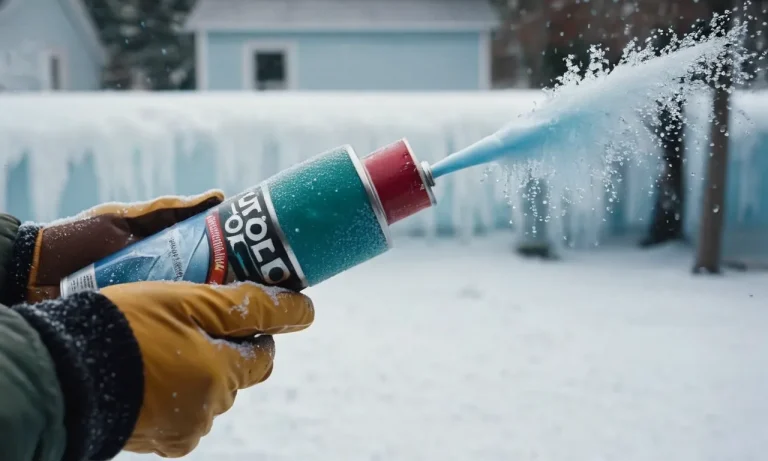Is Acrylic Paint Waterproof? Everything You Need To Know
Acrylic paint is a popular medium for both amateur and professional artists. Its versatility, fast drying time, and water-resistant qualities make it an ideal choice for many painting techniques and surfaces. But is acrylic paint completely waterproof?
The short answer is no, acrylic paint is not 100% waterproof. However, once dry, acrylic paint becomes very water-resistant due to its plastic polymer composition. With proper preparation and care, acrylic paintings can withstand exposure to water without damage.
In this comprehensive guide, we’ll cover everything you need to know about the water-resistant properties of acrylic paint and how to protect acrylic artworks from water damage.
The Basic Properties of Acrylic Paint
Acrylic is a fast-drying paint made of pigment suspended in acrylic polymer emulsion
Acrylic paint is a versatile medium that has gained popularity among artists for its vibrant colors and quick-drying properties. It is made by mixing pigment particles with an acrylic polymer emulsion, which acts as a binder.
This binder helps the paint adhere to various surfaces, making it suitable for a wide range of applications, including canvas, wood, and even plastic.
The acrylic binder is what makes acrylic paint water-resistant when dry
One of the key properties of acrylic paint is its water resistance when dry. This is due to the acrylic binder present in the paint. The binder forms a protective film over the pigment particles as the paint dries, creating a barrier that prevents water from seeping into the paint layer.
As a result, acrylic paintings are less prone to damage from moisture compared to other types of paint, such as watercolors or oil paints.
Acrylic paint becomes water-resistant in about 24 hours as it cures
While acrylic paint dries to the touch quite quickly, it takes about 24 hours for it to fully cure and become water-resistant. During this curing process, the water in the paint evaporates, and the acrylic polymer particles link together to form a solid film.
Once the paint has fully cured, it becomes more durable and less likely to be affected by water or other environmental factors.
When wet, acrylic paint is water-soluble, but becomes water-resistant when dry
When acrylic paint is wet, it is water-soluble, meaning it can be easily diluted and cleaned up with water. This makes it convenient for artists to mix colors, create washes, or clean their brushes. However, once the paint dries, it transforms into a water-resistant state.
This means that once the acrylic paint has cured, it will not dissolve or run when exposed to water. This property allows artists to layer, glaze, and varnish their acrylic paintings without worrying about the colors bleeding or smudging.
Key Factors That Affect Water Resistance
When it comes to determining whether acrylic paint is waterproof, there are several key factors that play a significant role. These factors can affect how well the paint holds up against water and moisture. Let’s take a closer look at some of these important factors:
Paint film thickness
The thickness of the paint film is an important factor to consider when determining water resistance. Generally, thicker layers of acrylic paint tend to provide better water resistance compared to thinner layers.
This is because the thicker paint film creates a stronger barrier against water and helps to prevent it from seeping through to the surface underneath. However, it’s worth noting that even thick layers of acrylic paint may not be completely waterproof, especially if the paint has not been properly sealed or varnished.
Surface preparation and primer
The surface preparation and the use of a suitable primer can have a significant impact on the water resistance of acrylic paint. Properly preparing the surface before applying the paint ensures better adhesion and helps to seal the surface, making it more resistant to water.
Additionally, using a primer specifically designed for acrylic paints can further enhance water resistance. Primers create a smooth and durable surface for the paint to adhere to, improving its ability to withstand moisture and water exposure.
Varnishing
Varnishing is an essential step in protecting acrylic paintings from water damage. Applying a layer of varnish over the dried acrylic paint not only adds a protective coating but also enhances the vibrancy and longevity of the artwork.
Varnishes come in different finishes, such as gloss, satin, and matte, and they can provide varying levels of water resistance. It is recommended to choose a varnish that offers good water resistance to ensure the longevity of your acrylic paintings.
It’s important to note that while these factors can improve the water resistance of acrylic paint, they do not guarantee complete waterproofing. Acrylic paint, by its nature, is water-based and can still be affected by prolonged exposure to water or harsh weather conditions.
For added protection, it’s always a good idea to keep your acrylic paintings away from direct water sources and to handle them with care.
If you’d like to learn more about acrylic paint and its water resistance, you can visit www.winsornewton.com for additional information and resources.
How to Make Acrylic Paintings Waterproof
Use an absorbent, rigid painting surface
When it comes to making your acrylic paintings waterproof, choosing the right painting surface is crucial. Opt for an absorbent and rigid surface such as canvas or wood panels. These materials allow the paint to adhere properly and prevent water from seeping through.
Apply an isolation coat
An isolation coat acts as a protective layer between your painting and the varnish. It helps to prevent the varnish from interacting with the paint directly, ensuring its longevity. To apply an isolation coat, mix a matte medium with water and gently brush it over the entire surface of your painting.
Allow it to dry completely before moving on to the next step.
Use adequate paint thickness
Applying acrylic paint in thin layers may not provide enough protection against water damage. To make your paintings waterproof, consider using a thicker application of paint. By applying multiple layers or using impasto techniques, you can create a more durable and water-resistant surface.
Allow proper drying/curing time
Proper drying and curing time is essential to ensure the longevity and waterproof nature of your acrylic paintings. Follow the manufacturer’s instructions regarding drying times, as it can vary depending on the brand and type of acrylic paint used.
Rushing the drying process may result in a weakened paint film that is more susceptible to water damage.
Apply a protective varnish
The final step in making your acrylic paintings waterproof is to apply a protective varnish. A varnish creates a barrier that shields the paint from moisture, UV rays, and other environmental factors. Choose a varnish specifically designed for acrylic paintings and follow the instructions carefully for best results.
Applying multiple coats of varnish can provide added protection.
By following these steps, you can ensure that your acrylic paintings are well-protected and waterproof. Remember to handle and store your artwork with care to maintain its longevity. If you’re looking for more detailed information, you can visit www.art-is-fun.com for additional tips and techniques on waterproofing acrylic paintings.
Water Exposure Risks for Acrylic Paintings
Acrylic paint is a popular choice among artists due to its vibrant colors, versatility, and quick drying time. However, when it comes to water exposure, there are some risks that artists should be aware of.
Direct water contact can damage uncured acrylic paint
Uncured acrylic paint refers to paint that hasn’t fully dried yet. If you expose uncured acrylic paint to water, it can cause the paint to become diluted, resulting in a loss of color intensity and adhesion. Additionally, water can cause the paint to run or bleed, potentially ruining the artwork.
Therefore, it is important to avoid direct water contact with uncured acrylic paint.
Fully cured acrylic paint is water-resistant but not fully waterproof
Once acrylic paint has fully dried and cured, it becomes water-resistant. This means that it can withstand some exposure to water without immediate damage. However, it is important to note that fully cured acrylic paint is not completely waterproof.
It can still be affected by prolonged or repeated water exposure.
Moisture can still penetrate and lift acrylic paint over time
Although fully cured acrylic paint is water-resistant, it is not impervious to moisture. Over time, moisture can still penetrate the paint film and cause it to lift or peel. This is especially true if the painting is exposed to humid environments or subjected to changes in temperature and humidity.
To protect your acrylic paintings, it is recommended to keep them in a controlled environment with stable humidity levels.
Solubility increases with repeated or prolonged water exposure
With repeated or prolonged water exposure, the solubility of acrylic paint increases. This means that the paint can start to dissolve or soften, making it susceptible to damage. It is important to avoid exposing acrylic paintings to excessive moisture or water for extended periods of time to prevent potential solubility issues.
Caring for Acrylic Paintings
Acrylic paintings are a popular choice among artists due to their versatility and vibrant colors. However, it is important to take proper care of these artworks to ensure their longevity. Here are some tips on how to care for acrylic paintings:
Allow adequate drying time before exposing paint to moisture
Acrylic paint dries relatively quickly, but it is still important to allow it to fully cure before exposing it to moisture. This can take anywhere from a few days to a couple of weeks, depending on the thickness of the paint layers. Patience is key to prevent any potential damage to the artwork.
Apply protective varnish coats
To enhance the durability and longevity of acrylic paintings, it is recommended to apply a protective varnish coat. Varnish not only adds a glossy or matte finish to the artwork but also acts as a barrier against moisture, UV rays, and dust.
It helps in preserving the vibrancy of the colors and prevents the paint from fading or yellowing over time.
Avoid direct water contact as much as possible
While acrylic paint is water-resistant once it dries, it is not completely waterproof. Direct contact with water for prolonged periods can cause the paint to soften, dissolve, or lift from the surface.
Therefore, it is advisable to avoid placing acrylic paintings in areas where they are likely to come into contact with water, such as bathrooms or kitchens.
Clean with a damp cloth minimally
When it comes to cleaning acrylic paintings, less is more. Excessive or vigorous cleaning can damage the paint surface. Instead, use a soft, lint-free cloth dampened with water or a mild cleaning solution specifically designed for acrylic paintings.
Gently dab the cloth on the surface to remove dust or dirt. Avoid rubbing or scrubbing the paint.
Store acrylic art out of bathrooms/kitchens
Proper storage plays a crucial role in preserving the quality of acrylic paintings. Avoid storing them in areas with high humidity, such as bathrooms or kitchens, as the moisture in the air can affect the paint and cause mold or mildew growth.
Instead, opt for a dry and well-ventilated space where the paintings can be stored upright or laid flat to prevent any warping or damage.
Conclusion
In summary, while acrylic paint has water-resistant properties when fully dry, it is not completely impervious to water damage without proper preparation and care. Following best practices for surface prep, paint thickness, drying time, varnishing, and storage is key to improving the water resistance of acrylic artwork.
With adequate moisture protection, acrylic paint can produce durable, long-lasting works of art.







